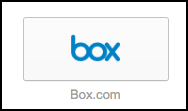Logging into Box
Because Box is an online service you'll need to log into Box before you can start using it. You can get to Box from work.path.org.
- Log into work.path.org and click the Box app button.

Once you log in, you'll go to your Box documents page. From here you can start uploading content to Box so you can access it using a browser or via a locally synced folder.
Uploading Files and Folders to Box
You can upload content to Box right away by:
- Dragging and dropping files and folders into Box
- Using the upload button to select individual files and folders to upload
For more on these two methods see this how-to: How to upload files and folders to Box.
Moving Your Content to Box
Moving content from your computer - Documents folder, desktop, etc.
- Files and folders saved locally can be uploaded to Box through your browser or they can be synced once you have sync enabled.
Moving content from OneDrive for Business/Dropbox/Google Drive
- Any synced files or folders can be uploaded to Box or they can be synced since those services normally also have a locally synced folder.
Moving content from the J Drive
- Files and folders on the J drive can be moved to Box just like locally stored files, as long as you have access to the J drive. If you are migrating a lot of files, you'll need to maintain a connection to both the J drive and Box while the files are copying.
Sharing Files and Folders (replacing email attachments)
Once you have files and folders saved in Box you may want to share some of those files or folders with others. Sharing and collaborating are two different ways of doing that.
Sharing files and folders lets you send a link instead of an attachment. This is an easy way to give others read-only access to a file or folder. You can share a file or folder with anyone, even if they do not have a Box account. Sharing is a one-way relationship in the same way as sending an attachment. Recipients can download a document or the contents of a folder, but they cannot make changes to the content of that document or folder.
Sharing a file or folder
- Hover over the file or folder you'd like to share. In the example below we're sharing a folder but the process is the same for a file.

- Click the Share button.
- Select Get Shared Link

- Click Copy if you'd like to attach the Shared Link into an email.
- Enter the name (if sharing within PATH) or email address of those you'd like to share the folder with.
- Enter a message explaining what you're sharing and why. This helps the recipient understand what you're sharing.
- Click Send and the link will be sent out to the recipient(s).
By default, anyone with the link can open the shared file or folder. This behaves just like sending an attachment. Unlike an attachment, you have additional advanced options to give you more flexibility and control over your shared content.
Disabling a shared link
You can disable a shared link at any time, removing access to the shared file or folder.

8. Go back to the sharing pane (step 2 above) and click People with the link.
9. Click Remove Link and then close the pane. This will unshare the file or folder.
When you share a folder, you share the entire folder and its contents. This is still shared as read-only so the recipient cannot add or remove files from the folder. They'll just be able to view and download the content. This is not something you can do with an attachment.
Collaborating on Files and Folders
Sharing files or folders gives any recipient read-only access to files and/or folders, but sometimes you want a recipient to make changes or a file or the contents of a folder. You may need someone to edit a document or add/remove files from a folder. To do this, you need to invite the recipient as a collaborator. To invite someone as a collaborator, he or she must have a Box account.
To invite someone to collaborate on a folder
- Navigate to the folder you'd like to invite others to and click the Share button to the far right of the folder.
Click Invite Collaborators.

- Enter the names or email address of anyone you'd like to invite as a collaborator. Collaborators will be able to edit files and folders based on the permissions you give them.
- Select the permission level for the people you're inviting. Not sure what permissions do what? Click the "i" next the Learn More to learn more.
- Enter an optional message.
- Click Send Invites to send out your invitations to collaborate.

- Folders that you are collaborating on are denoted with a blue folder icon. This makes it easy to visually determine what folders you're collaborating on.

- Your invited collaborators will receive an email notification as well as a notification within Box itself letting them know they have been invited to collaborate on a folder. The folder will appear in their folder list and it can be easily synced to their local computer.
Syncing Files to Your Local Computer Using Box Drive
Much of your interaction with Box will be and should be done in your browser. There are times when you will want to have folders and files synced locally. This is useful if you spend time in areas with no Internet access, if you access certain files regularly, or if you need to do complex searches on your files using your operating system's search features. Box Drive lets you sync folders you choose to your computer.
Additional Resources
Please see these Box Training resources for more help getting started with Box.
BOX University






